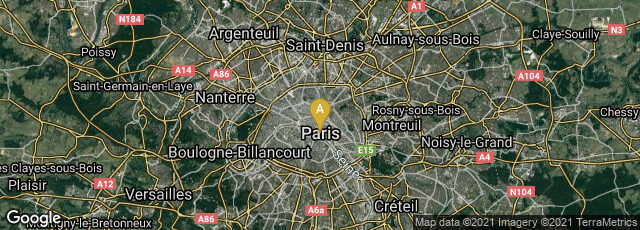

A: Paris, Île-de-France, France
Having previously published in 1802 a fourth and supplementary volume to Caillot and Duclos' Dictionnaire bibliographique, historique et critique des livres rares, in 1810 French antiquarian bookseller Jacques Charles Brunet issued in 3 volumes the Manuel du libraire et de l'amateur de livres, contenant
1.* Un Nouveau dictionnaire bibliographique, Dans lequel sont indiqués les Livres les plus précieux et les Ouvrages les plus utiles, tant anciens que moderns, avec des notes sur les différentes éditions qui ont été faites, et des remarques pour en reconnaitres les contrefaçons; on y a joint des détails nécessaires pour collationner les Livres anciens et les principaux Ouvrages à Estampes; la concordance des prix auxquels les éditions les plus rares ont été portées dans les ventes publiques faites depuis quarante ans, et l'évaluation approximative des Livres anciens qui se recontrent fréquement dans le commerce de la Librairie;
2.* Une table en forme de catalogue raisonné, Où sont classés méthodiquement tous les Ouvrages indiqués dans le Dictionnaire, et de plus, un grand nombre d'Ouvrages utiles, mais d'un prix ordinaire, qui n'ont past dû être placés an rang des Livres précieux.
Brunet continued to revise and expand this encyclopedic guide during the rest of his life, completing the fifth edition in six volumes published from 1860-1865. Three supplementary volumes by booksellers Pierre Deschamps and Pierre Gustave Brunet were published from 1870 to 1880. This encyclopedic reference for antiquarian booksellers and collectors contained annotations concerning the scholarly and commercial value of rare books that in some cases remain unsurpassed in the early 21st century. More significantly it provided bibliographical, scholarly, and price information in one convenient, authoritative reference that was and often remains invaluable for antiquarian booksellers, collectors, bibliographers, and librarians.
One of the many ways in which Brunet's work was useful and influential was in his expansion of the then-traditional classification scheme for information used in France since the beginning of the 18th century. This classification scheme, which divided information into five great divisions, originated in the seventeenth century, and was promoted by the first great book auctioneer in Paris, Gabriel Martin, who first employed it in the Bigot sale in 1706. The scheme, which was expanded by Prosper Marchand in Catalogus librorum bibliothecae Joachimi Faultrier digestus a Prospero Marchand (1709), categorized information into the following subject areas: theology, jurisprudence, sciences and arts (initially called philosophy), belles-lettres (humane letters), and history. Thomas Hartwell Horne summarized Marchand's system in his Outlines for the Classification of a Library (1825) 3:
"The system of Prosper Marchand, an eminent Bookseller of Paris during the former part of the eighteenth century, is developed in his preface to the catalogue of the Library of M. Faultrier. Marchand first considers the different orders, according to which a Bibliographical System may be formed, viz. The natural order, the order of nations, the order of languages, the chronological order, and the alphabetical order. He then exhibits his plan, which he divides into three primary chapters, to comprehend the several classes of Books. To these he prefixes Bibliography, by way of introduction, and subjects Polygraphy as an appendix. The three primary chapters or fundamental classes are— Human Science or Philosophy, Divine Science or Theology, and the Science of Events or History. Philosophy is divided into two parts— Literae Humaniores or the Belles Lettres, and Literae Severiores, or the Sciences. The system of Marchand had many admirers when it first appeared, but it has been superceded by that of De Bure. . . ."
Marchand's Latin preface to the Faultrier catalogue, incorrectly dated 1704, was translated into French and published in Claude-François Achard's, Cours elémentaire de bibliographie vol. 2 (1807) 100-106. In January 2015 I acquired from Librairie Paul Jammes in Paris a variant separate printing of Marchand's 52-page introduction to the Faultrier catalogue, with the addition of an index in very small type printed on its last leaf. This undated pamphlet, presumably issued in 1709, was entitled Epitome systematis bibliographici, seu ordinis recte distribuendi librorum catalogi. My copy is bound in a volume with other works and may be lacking a separate title page, if one was issued. By comparing the online version of the complete catalogue with my version of the introduction, I have concluded that they were issued by the same printer, using the same typeface and the same ornamental head and tailpieces, but from a different setting of type. Most notably, on the first page of my version, Prosper Marchand identifies himself as the author, which he does not do in the full Faultrier catalogue. The index added to the text of my copy does not appear in the version that prefaces the Faultrier catalogue.
In Brunet's time Marchand's basic scheme, as modified by De Bure and others, was still used in French library cataloguing schemes, limiting the utility of subject cataloguing. In the third volume of his Manuel Brunet published Ordre des principales divisions de la table méthodique des ouvrages cités dans le nouveau Dictionnaire Bibliographique. This divided the traditional five subject categories into numerous sub-categories and divisions within those sub-categories. This he followed by listings of significant books in each of the categories and sub-categories in the classification scheme.
Breslauer & Folter, Bibliography: Its History and Development (1984) No. 118.